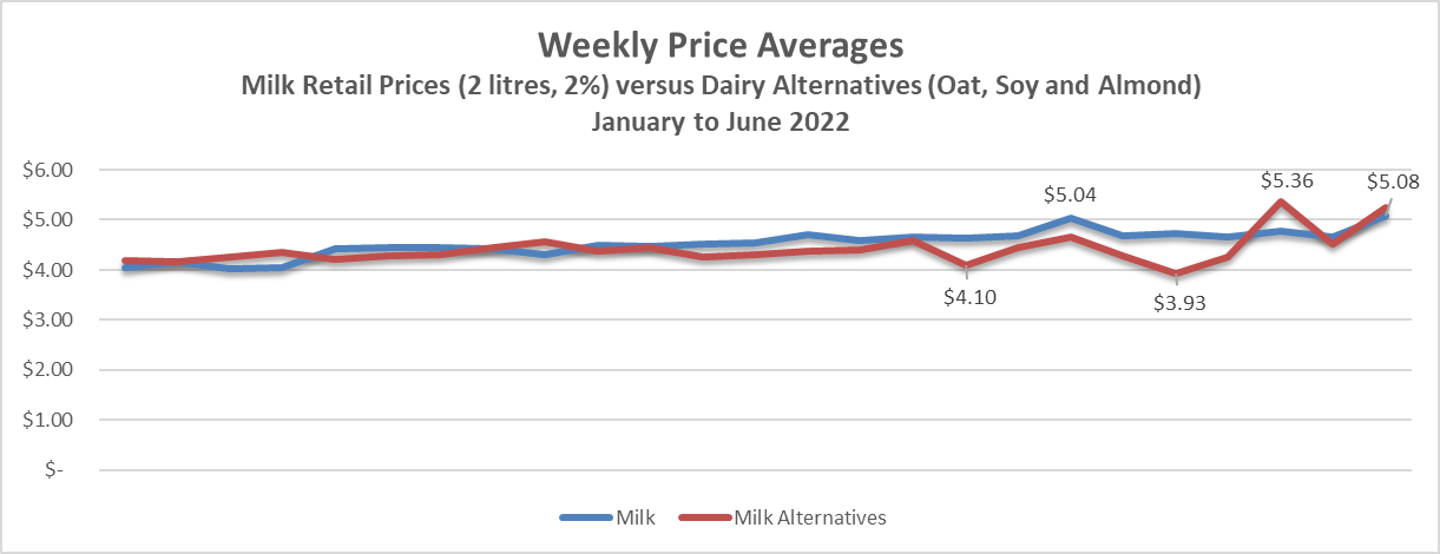Milk prices now on par with dairy alternatives: Study
Shoppers are used to forking over more for plant-based milk. But a new study from the Agri-Food Analytics Lab (AAL) at Dalhousie University suggests dairy alternatives are now at parity with milk. And the cost of both is on the rise.
The lab, in partnership with BetterCart Analytics, compared retail prices of fluid milk with dairy alternatives across Canada’s provinces. The survey looked at the price of two-litre milk (2%) and compared it with soy, almond, and oat-based beverages. The two-litre format was chosen since dairy alternatives are typically sold in this format.
The study found that lowest average price surveyed for milk was $4.03 in January, while the lowest average price for dairy alternatives was $3.93 in May. The highest average price for milk was $5.08 at the end of June, while the highest average price for dairy alternatives was $5.36 in early June.
In the report, AAL notes The Canadian Dairy Commission called for a record increase in the price of milk on the farm by 8.4% last fall, with an additional 2.5% increase coming in September. According to AAL, prices for both milk and dairy alternatives increased significantly between January and June 2022: Milk increased by 25% and dairy alternatives increased by 31%.
“With recent hikes [in dairy], I certainly was expecting the alternatives to be much cheaper than milk, but we’ve been at parity for the most part for a while,” says AAL director Sylvain Charlebois. While costs have gone up for producers of milk alternatives, the report states how prices have behaved in this section of the grocery store is difficult to explain, based on the evidence at hand.
The study also looked at provincial differences, finding that dairy alternatives are cheaper (7% on average) in Ontario, Quebec and Prince Edward Island. In Manitoba, the differential between milk and dairy alternatives is the highest, at 17%. The other three Atlantic provinces also have high average differentials: New Brunswick (16%), Nova Scotia(13%), Newfoundland and Labrador (11%). With milk being 1% cheaper, British Columbia is essentially at parity. When all provinces are combined, milk is 5% cheaper than dairy alternatives.
A similar AAL study, released in April, compared the cost of meat products with plant-based alternatives. It found that even though the price of meat is on the rise, plant-based alternatives are still more expensive.
The milk report notes that dairy alternatives, positioned to compete with milk, are now competitively priced in most parts of the country. “Unlike meat alternatives, dairy alternatives do offer a financially accessible option for Canadians who want to reduce their consumption of fluid milk,” the report states.
“The takeaway is that consumers have options,” says Charlebois. “We are at parity, so if people are concerned about milk or they want to seek other options, they can financially. But, I would say milk still has the advantage because milk is offered in many different formats and that really allows consumers to save.”
Methodology: Data was collected between January 1 and June 30, 2022, in 10 provinces. Stores operated by Walmart, Loblaw, Empire/Sobeys, Save-On-Foods and Metro were included in the analyses.
Nearly 83,000 data points were included in the survey. The analysis is based on averages, from week to week, as all brands carried by all retailers were included in the survey. Organic products were not included in the survey.


